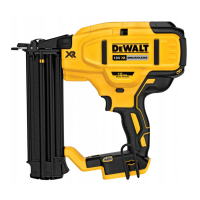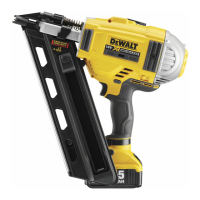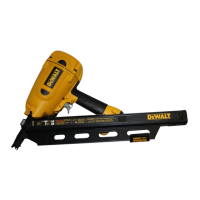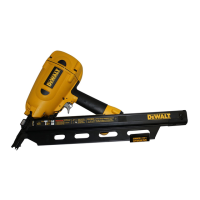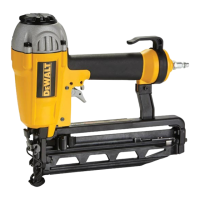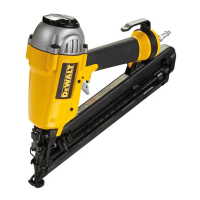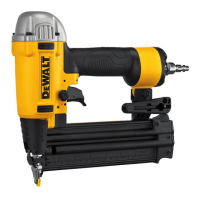12
ENGLISH
time the contact trip is depressed. This allows the user to
drive multiple staples insequence.
WARNING: Do not keep trigger depressed when tool is not
in use. Keep the trigger lock‑off in the locked position when
the tool is not inuse.
WARNING: When the tool’s motor is running, pulling the
trigger or depressing the contact trip will cause a staple
tobedriven.
Preparing the Tool
WARNING: NEVER spray or in any other way apply
lubricants or cleaning solvents inside the tool. This can
seriously affect the life and performance of thetool.
NOTE: The battery pack is not fully charged out of the carton.
Follow instructions outlined (see Charging aBattery).
1. Read the Safety Instruction section of thismanual.
2. Wear eye and earprotection.
3. Ensure magazine is empty of allfasteners.
4. Check for smooth and proper operation of contact trip and
pusher assemblies. Do not use tool if either assembly is not
functioning properly. NEVER use a tool that has the contact
trip restrained in the actuatedposition.
5. Keep tool pointed away from yourself andothers.
6. Insert fully charged batterypack.
Using the Trigger Lock‑off (Fig.E)
WARNING: To reduce the risk of serious personal injury,
do not keep trigger depressed when tool is not in use. Keep
the trigger lock‑off switch LOCKED (Fig. E) when the tool
is not inuse.
WARNING: To reduce the risk of serious personal
injury, lock off trigger, disconnect battery pack from
tool and remove staples from magazine before
makingadjustments.
Each DeWALT stapler is equipped with a trigger lock‑off
2
which when pushed to the right as shown in FigureE, prevents
the tool from firing a staple by locking the trigger and bypassing
power to themotor.
When the trigger lock‑off is pressed to the left, the tool will be
fully operational. The trigger lock‑off should always be locked
off whenever any adjustments are made or when tool is not in
immediateuse.
NOTICE: Do not store tool with battery pack installed. To
prevent damage to the pack and to ensure best battery
life, store battery packs out of the tool or charger in a cool,
drylocation.
Loading the Tool (Fig.F)
WARNING: Keep the tool pointed away from yourself and
others. Serious personal injury mayresult.
WARNING: Never load staples with the contact trip or
trigger activated. Personal injury mayresult.
WARNING: Always remove battery pack before loading or
unloading staples. Serious personal injury mayresult.
1. Press magazine latch
15
and open sliding
magazine
6
fully.
Proper hand position requires one hand on the main handle
asshown.
Mode Selection
The finish stapler is capable of firing staples using bump
actuation or sequential actuation. Before operating this tool,
look at the selector switch to determine the actuation mode.
Read all instructions before selecting actuationmode.
WARNING: Keep fingers AWAY from trigger when not
driving staples to avoid accidental fastener discharge.
NEVER carry tool with finger on trigger. In bump mode
tool will drive a staple if contact trip is bumped while
trigger isdepressed.
Sequential Action (Fig.D)
Use sequential actuation mode for intermittent stapling where
very careful and accurate placement and depth control is
desired. The sequential actuation mode provides the maximum
delivery of power for driving the longeststaples.
To operate the stapler in sequential actuation mode:
1. Slide the selector switch to expose the single staple
icon .
2. Fully depress nosepiece against the work surface (motor
willstart).
3. Pull trigger (staple will drive into worksurface).
4. Releasetrigger.
5. Lift nosepiece off worksurface.
6. Repeat steps 2through 4for nextapplication.
NOTICE: The contact trip needs to be depressed followed
by a trigger pull for each staple followed by a release of
both the contact trip and trigger after eachstaple.
Bump Action (Fig.D)
Bump action is intended for rapid stapling on flat, stationary
surfaces and typically most effective for applications that require
driving shorterstaples.
When the tool is set in the bump actuation mode, two
methods of tool operation are available: place actuation and
bumpactuation.
Slide the selector switch to expose the triple staple icon .
To operate the tool using the place actuation method:
WARNING: A staple will be driven each time the trigger is
depressed as long as the contact trip remainsdepressed.
1. Depress the contact trip against the worksurface.
2. Depress thetrigger.
To operate the tool using the bump actuation method:
3. Depress thetrigger.
4. Push the contact trip against the work surface. As long as
the trigger is depressed, the tool will drive a staple every
Proper Hand Position (Fig.C)
WARNING: To reduce the risk of serious personal injury,
ALWAYS use proper hand position asshown.
WARNING: To reduce the risk of serious personal
injury, ALWAYS hold securely in anticipation of a
suddenreaction.
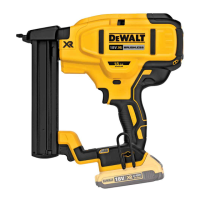
